Home > Research projects
Research projects
Programmed research projects
A01 Mechanism of Mycoplasma gliding
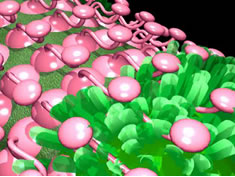
| Representative |  Makoto Miyata Makoto Miyata(Professor, Department of Biology, Graduate School of Science, Osaka City University, Bacteriology/Biophysics) |
|---|---|
| Cooperator (with funding) |
 Takayuki Nishizaka Takayuki Nishizaka(Professor, Department of Physics, Gakushuin University, Biophysics) |
| Cooperator (without funding) |
 Noriyuki Kodera Noriyuki Kodera (Associate Professor, Department of Physics & Bio-AFM Frontier Research Center, Kanazawa University, Biophysics) |
"Mycoplasma pneumonia" is getting pandemic (worldwide epidemic) these years for the first time in human history. This infectious disease is caused by 'Mycoplasma', a pathogenic bacterium. Mycoplasmas form an apparatus at its cell pole, "glide" by an unknown mechanism on the surfaces of host tissues. This motility is essential to Mycoplasma infection and reaches 4 micro meter per second in the fastest species. The project leader elucidated so far the gliding machinery and its component proteins, the direct energy source, the binding targets etc., and suggested a working model to explain the motility mechanism. In the present project, we perform the following studies to step into the core image of this working model, collaborating closely with other members in our project area. (1) 3D imaging of the gliding machinery by electron microscopy (Kato (Homma group), Katayama (Soukatsu group)), (2) Structural studies by crystallization (Imada (Ito group)), (3) Clarification of conformational changes in the gliding machinery coupled to ATP hydrolysis by optical microscopy and high speed AFM (Nishizaka, Kodera).
A01 Elucidation of the working principle of repetitive motors driving protein export
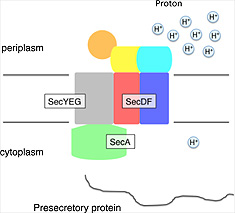
| Representative |  Hiroyuki Mori Hiroyuki Mori (Associate Professor, Institute for Virus Research, Kyoto University, Biochemistry) |
|---|---|
| Cooperator (without funding) |
 Tomoya Tsukazaki Tomoya Tsukazaki(Associate Professor, Graduate school of Biological Sciences, Nara Institute of Science and Technology, Structural Biology) |
Protein translocation is an essential biological reaction in all living organisms. In bacteria, SecA, the translocation ATPase, and SecYEG, the polypeptide-conducting channel, play central roles in protein export across the cytoplasmic membrane. In addition, membrane proteins SecDF that form a complex with SecYEG are required for efficient protein export. We determined crystal structures of all the above-mentioned Sec factors. The structural information as well as the structure-instructed biochemical analyses have led us to propose the following working model. SecA functions as the ATP driven motor repeatedly pushing a secretory polypeptide into the SecYEG channel on the cytoplasmic side. SecDF acts as the PMF-driven motor repeatedly pulling the translocating polypeptide on the other side (periplasmic side) of the membrane. It is thought that tThe two motors cooperatively function to achieve one-directional and efficient protein export in vivo.
Our objective is to substantiate the above model. In this project, we will perform biochemical analyses including in vivo site-directed photo-crosslinking based on the crystal structures of SecA and SecDF to elucidate in more detail how these repetitive motors convert the chemical energies into the polypeptide movement. In addition, we will try to crystallize the SecA-(SecYEG)2 and (SecYEG)2-SecDF complexes to resolve the overall structure of the Sec translocation machinery in collaboration with Dr. Tomoya Tsukazaki.
A02 Energy conversion mechanism of rotation in supramolecular motor of bacterial flagella
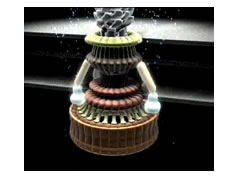
| Representative |  Michio Homma Michio Homma(Professor, Graduate School of Science, Nagoya University, Biophysics/Biochemistry) |
|---|---|
| Cooperator (with funding) |
 Takayuki Kato Takayuki Kato(Assistant Professor, Graduate School of Frontier Biosciences, Osaka University, Structural Biology) |
 Tohru Minamino Tohru Minamino(Associate Professor, Graduate School of Frontier Biosciences, Osaka University, Molecular Genetics) |
|
| Cooperator (without funding) |
 Seiji Kojima Seiji Kojima(Lecturer, Graduate School of Science, Nagoya University, Biochemistry/Biophysics) |
 Chojiro Kojima Chojiro Kojima(Associate Professor, Institute for Protein Research, Osaka University, Biophysics) |
|
 Hideki Kandori Hideki Kandori(Professor, Nagoya Institute of Technology) |
Bactrial flagellum is a supramolecular machinery to make rotary motion at high speed and the energy souse is ion influx or ion motive force. The component proteins of the rotor and the stator in the supramolecular machinery have been identified and some of their atomic structures have been resolved. However, it is still unknown how to convert the ion current into rotational force. In this project, we want to strongly promote the dynamic structural analysis of the motor proteins and clarify the principle of interaction between the proteins to generate a force. For this structural analysis, NMR, X-ray crystal, and cryo-electron microscope will be complementally used. In addition to the structural aspects, the method of nano-optical measurement is developed to analyze the movement of rotation with high time-resolution and we want to detect the step of rotor-stator interaction. The molecular mechanism how to convert the ion flux into the mechanical force would be clarified.
A02 The elucidation of the molecular mechanisms of ion selectivity of hybrid bacterial flagellar motors
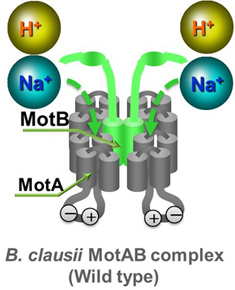
A schematic diagram of hybrid bacterial flagellar stator
| Representative |  Masahiro Ito Masahiro Ito(Professor, Bio-Nano Electronics Research Centre, Toyo University, Extremophiles) |
|---|---|
| Cooperator (without funding) |
 Katsumi Imada Katsumi Imada(Professor, Graduate School of Science, Osaka University, Structural Biology) |
The bacterial flagellum acts as the propeller for cell locomotion in a variety of environments. The flagellar motor, consisting of the rotor and the stator, rotates the flagellar filament. All the bacterial flagellar motors characterized so far are energized by either transmembrane electrochemical gradients of protons or sodium ions that are coupled to motility via membrane embedded stator complexes. Some bacteria possess stator complexes of only one ion-coupling type, either protons or sodium, while others have two flagellar systems that have different ion-coupling properties. Use of sodium ions is associated with elevated pH and a high salt environment. Among the reported stators, MotAB-type stators use protons while MotPS- and PomAB-type stators use Na+ as coupling ions. Previously, our group reported that the flagellar motor of Bacillus subtilis is a hybrid motor consisting of both MotAB and MotPS (Ito et al., 2005), and that of Bacillus clausii is a dual-specificity motor consisting of MotAB that has selectivity for both H+ and Na+ (Terahara et al., 2008). We also reported that a novel type of bacterial flagella motor from an alkaliphilic bacterium, Bacillus alcalophilus, can use K+ as a coupling ion (Terahara et al, 2012). It is thought that the flagellar stator of Bacillus species evolved to adjust to the environment. However, the molecular mechanisms of ion selectivity of the flagellar stator have not yet been elucidated. The elucidation of the details will considerably affect the understanding of the operating principles of flagellar motors and the molecular mechanisms of ion selectivity. It will also affect the fields related to the evolution of environmental changes and stresses and nanotechnology.
In our project, we conduct researches exploring the differences between a hybrid stator and only one ion-coupling type stator with interdisciplinary collaboration of molecular biology and structure biology, which will enable us to gain a holistic understanding of the mechanisms of ion selectivity of flagellar motors. Furthermore, research will focus on the principal of dynamics of the molecular motor in collaboration with Professor Homma’s group.
A03 Structure and dynamics of gliding motility machinery of Bacteroidetes bacteria
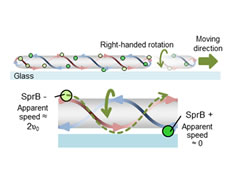
| Representative |  Koji Nakayama Koji Nakayama (Professor, Graduate School of Biomedical Sciences, Nagasaki University, Bacteriology) |
|---|---|
| Cooperator (with funding) |
 Keiko Sato Keiko Sato (Assistant Professor, Graduate School of Biomedical Sciences, Nagasaki University, Bacteriology) |
| Cooperator (without funding) |
 Daisuke Nakane Daisuke Nakane(Assistant Professor, Department of Physics, Gakushuin University, Biophysics) |
Many members of the bacterial phylum Bacteroidetes move rapidly over surfaces at speeds of 1–3 μm/s, which is called gliding motility. Some of the proteins required for gliding are components of a Bacteroidetes-specific protein secretion system named Por secretion system or type 9 secretion system, which was originally identified in a nonmotile periodontal pathogen, Porphyromonas gingivalis, indicating that a multifunctional machine plays roles in gliding motility and protein secretion. Recently, fluorescence microscopy revealed that SprB protein, which is a 669-kDa cell-surface adhesin of the gliding bacterium Flavobacterium johnsoniae, moves from pole to pole along what appears to be a closed helical loop track at 2 μm/s. We propose a helical loop track model for Flavobacterium gliding in which cell-surface motility adhesins such as SprB are propelled along a left-handed helical loop track, generating rotation and translation of the cell body. We collaborate with other research groups for elucidating the mechanism of gliding motility. In addition to genetic analysis, the following analyses will be performed. (i) 3D visualization of the machine under an optical microscope (Miyata group and Nishizaka), (ii) Isolation, crystallization, crystal structure analysis of core proteins of the machine (Ito group and Imada) and electron microscopic analysis of the proteins (Homma group and Kato), (iii) analysis of a connection between gliding machinery and skeletal structure of bacterial cells (Ueda group).
A03 Structure and Function of Magnetotaxis Machinery
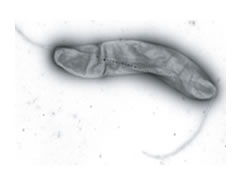
| Representative |  Yoshihiro Fukumori Yoshihiro Fukumori(Professor, Graduate School of Natural Science and Technology Kanazawa University, Biochemistry) |
|---|---|
| Cooperator (without funding) |
 Azuma Taoka Azuma Taoka(Assistant Professor, Graduate School of Natural Science and Technology Kanazawa University, Biochemistry) |
Magnetotactic bacteria have found a favorable niche for the growth in the natural environment by sensing geomagnetic field and swimming in parallel with the lines. Magnetotaxis is thought to be close cooperation between two supramolecular complexes, Input Machinery “Magnetosomes” as magnetic sensor and Output Machinery “Flagella” as mobile device. In the present study, we will elucidate the molecular mechanism of magnetosome formation and then functional connectivity of the magnetosomes with flagella by the techniques in microbiology, biophysics and cell biology. When we have known functional mechanism of Magnetotaxis Machinery, the studies obtained should lead to elucidation of the bacterial magnetic sensing mechanism and also to development of new technology as giving a magnetotactic properties into useful microorganism. Furthermore, our studies will approach the formation and functional mechanism of prokaryotic organelle and contribute to both sides of Fundamentals and Applications of microbiology.
A03 Actin structural polymorphism machinery that controls amoeboid movements.
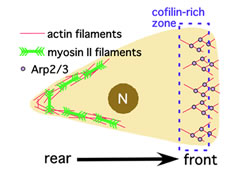
| Representative |  Taro Q.P. Uyeda Taro Q.P. Uyeda(purofessor, Department of Physics, Factory of Science and Engineering,Waseda University, Biophysics/Cell Biology) |
|---|---|
| Cooperator (with funding) |
 Kiyotaka Tokuraku Kiyotaka Tokuraku(Associate Professor, Muroran Institute of Technology, Biochemistry) |
 Akira Nagasaki Akira Nagasaki(Senior Researcher, Biomedical Research Institute, National Institute of Advanced Industrial Science and Technology, Cell Biology) |
|
 Taro Noguchi Taro Noguchi(Substance Engineering,National Institute of Technology, Miyakonojo colledge) |
|
| Cooperator (without funding) |
 Eisaku Katayama Eisaku Katayama(Researcher, Graduate School of Science, Osaka City University, Structural Biology) |
| Cooperator |  Takeyuki Wakabayashi Takeyuki Wakabayashi(Professor, Teikyo University ) |
| Cooperator |  Mitsunori Takano Mitsunori Takano(Professor, Waseda University) |
| Cooperator |  Yuki Gomibuchi Yuki Gomibuchi(Postdoctoral, Teikyo University) |
Actin filaments play essential roles in a variety of important functions in eukaryotic cells, and each of these actin functions depends on interaction with specific actin binding proteins. In a migrating amoeba cell, for instance, interaction with Arp2/3 induces polymerization of actin filaments and pushes the leading membrane forward, while interaction with myosin drives posterior contraction. It is not well understood, however, how actin filaments at different parts within one cell interact with different actin binding proteins. We have proposed that actin filaments are able to adopt different conformations, and filaments with different conformations interact with different actin binding proteins, leading to functional differentiation. The goal of this project is to obtain a comprehensive picture regarding relationships between the structural polymorphism and the functional differentiation of actin filaments through biochemical, cell biological and structural biological studies. In addition, we will collaborate with A03 Dr. Fukumori's project to investigate whether bacterial actins also exhibit structural polymorphism to drive functional differentiation, with the aim of understanding the similarities and differences between eukaryotic and prokaryotic actins.
Openly recruited research projects(2015-2016)
A01 Mechanism of a microtubule-dependent motility of the multifunctional machinery haptonema
| Representative |  Kazuo Inaba Kazuo Inaba(Professor,Shimoda Marine Research Center, University of Tsukuba) |
|---|---|
| Cooperator (without funding) |
 Kogiku Shiba Kogiku Shiba(Assistant professor,Shimoda Marine Research Center, University of Tsukuba) |
| Cooperator (without funding) |
 Keiko Hirose Keiko Hirose(Chief Senior Researcher,Biomedical Research Institute, National Institute of Advanced Industrial Science and Technology (AIST)) |
A01 Machinery of various motile mode driven by supramolecular complex of dynein and its regulatory proteins
| Representative |  Yoko Y. Toyoshima Yoko Y. Toyoshima(Professor、Department of Life Sciences, Graduate School of Arts and Sciences, The University of Tokyo) |
|---|---|
| Cooperator (without funding) |
 Takashi Murayama Takashi Murayama(Associate professor,Department of Pharmacology, Juntendo University School of Medicine) |
A01 Structure and dynamics of the gliding proteins from Mycoplasma mobile
| Representative |  Munehito Arai Munehito Arai (Associate Professor,Department of Life Sciences, The University of Tokyo) |
|---|---|
| Cooperator (without funding) |
 Yuuki Hayashi Yuuki Hayashi(Assistant Professor,Department of Life Sciences, The University of Tokyo) |
A01 Regulation of axonemal dynein motility by post-translational modifications of axonemal microtubule
| Representative |  Koji Ikegami Koji Ikegami(Associate professor, Department of Cell Biology and Anatomy, Hamamatsu University School of Medicine) |
|---|---|
| Cooperator (without funding) |
 Takayuki Nishizaka Takayuki Nishizaka(Professor, Department of Physics, Faculty of Science, Gakushuin University) |
| Cooperator (without funding) |
 Masaki Edamatsu Masaki Edamatsu(Assistant professor, Department of Life Sciences, Graduate School of Arts and Sciences, The University of Tokyo) |
A01 Survival strategy of deep-see microorganisms at extreme environmental conditions
| Representative |  Masayoshi Nishiyama Masayoshi Nishiyama(Program-specific Associate Professor,The HAKUBI Center for Advanced Research, Kyoto University) |
|---|---|
| Cooperator (without funding) |
 Chiaki Kato Chiaki Kato(Senior Staff (Principal Scientist,JAMSTEC) |
A01 Surface motility in eukaryotic flagella: generality and membrane dynamics
| Representative |  Ritsu Kamiya Ritsu Kamiya (Guest Researcher, Faculty of Science, Gakushuin University) |
|---|
A01 Structural analysis of protein components of the attachment organelle of Mycoplasma pneumoniae
| Representative |  Tsuyoshi Kenri Tsuyoshi Kenri(Chief,Department of Bacteriology II,National Institute of Infectious Diseases) |
|---|---|
| Cooperator (without funding) |
 Shigetarou Mori Shigetarou Mori(Chief,Department of Bacteriology II,National Institute of Infectious Diseases) |
| Cooperator (without funding) |
 Takashi Shimizu Takashi Shimizu(Associate professor,Joint Faculty of Veterinary Medicine,Yamaguchi University) |
A02 Motion control mechanism of voltage-driven molecular motor proteinsr
| Representative |  Rikiya Watanabe Rikiya Watanabe(Department of Applied Chemistry, The University of Tokyo,Assistant Professor) |
|---|---|
| Cooperator (without funding) |
 Naoki Soga Naoki Soga(Department of Applied Chemistry, The University of Tokyo) |
A02 Mechanism for regulating integrin machinery in immune cells
| Representative |  Akihiko Nishikimi Akihiko Nishikimi(Associate professor, Kitasato University School of Science ) |
|---|---|
| Cooperator (without funding) |
 Koko Katagiri Koko Katagiri(Professor, Kitasato University School of Science) |
| Cooperator (without funding) |
 Sayaka Ishihara Sayaka Ishihara(Research Associate, Kitasato University School of Science) |
A02 Analysis of molecular assembly of the bacterial flagellar rotary motor
| Representative |  Yoshiyuki Sowa Yoshiyuki Sowa(Associate Professor, Department of Frontier Bioscience, Hosei University ) |
|---|
A03 Elucidation of protozoan invasion mechanism
| Representative |  Kentaro Kato Kentaro Kato(Project associate professor,National Research Center for Protozoan Diseases, Obihiro University of Agriculture and Veterinary Medicine ) |
|---|---|
| Cooperator (without funding) |
 Masaru Tanokura Masaru Tanokura(Professor,Graduate School of Agricultural and Life Sciences, The University of Tokyo) |
A03 Shape transformation and mechanics on the swimming of spirochetes
| Representative |  Shuichi Nakamura Shuichi Nakamura (Assistant Professor,Department of Applied Physics, Graduate School of Engineering, Tohoku University) |
|---|---|
| Cooperator (without funding) |
 Nobuo Koizumi Nobuo Koizumi(Senior Researcher,Department of Bacteriology,National Institute of Infectious Diseases) |
| Cooperator (without funding) |
 Fumio Hayashi Fumio Hayashi(Associate Professor,Instrumental Analysis Center, Organization for Promotion of Research and University Industry Collaboration, Gunma University) |
A03 An attempt of the autonomous construction of cytoplasmic streaming by myosin and actin
| Representative |  Kohji Ito Kohji Ito(Associate professor, Department of Biology, Graduate School of Science, Chiba University ) |
|---|---|
| Cooperator (without funding) |
 Yuichi Hiratsuka Yuichi Hiratsuka(School of Materials Science, Japan Advanced Institute of Science and Technology) |
A03 Study on dynamical polymorphism of polymeric filament and cooperative interaction of its associated protein
| Representative |  Mitsuhiro Sugawa Mitsuhiro Sugawa(Assistant Professor,Graduate School of Arts and Sciences, The University of Tokyo ) |
|---|---|
| Cooperator (without funding) |
 Junichiro Yajima Junichiro Yajima(Associate Professor,Graduate School of Arts and Sciences, The University of Tokyo) |
| Cooperator (without funding) |
 Atsuko H. Iwane Atsuko H. Iwane(Unit Leader,Quantitative Biology Center, Riken) |
A03 Regulatory mechanisms underlying phototaxis in the green alga Chlamydomonas reinhardtii
| Representative |  Ken-ichi Wakabayashi Ken-ichi Wakabayashi (Associate Professor, Chemical Resources Laboratory, Tokyo Institute of technology) |
|---|
A03 Analyses of bacterial gas vesicles and diverse motilities
| Representative |  Yosuke Tashiro Yosuke Tashiro(Assistant Professor,Division of Applied Chemistry and Biochemical Engineering, College of Engineering, Shizuoka University ) |
|---|
A03 Reconstitution of microtubule plus end dynamics
| Representative |  Gohta Goshima Gohta Goshima(Professor, Grad. Sch. of Sci. Nagoya Univ.) |
|---|
A03 Cellular machinery for collective cell movement in vivo
| Representative |  Asako Shindo Asako Shindo(Nagoya University ) |
|---|---|
| Cooperator (without funding) |
 Makoto Kinoshita Makoto Kinoshita(Nagoya University) |
| Cooperator (without funding) |
 Makoto Kinoshita Makoto Kinoshita(Nagoya University) |
| Cooperator (without funding) |
 Naoto Ueno Naoto Ueno(National Institute for Basic Biology) |
A03 Mechanism of quantitative and qualitative variation of phospholipids in membrane dynamics
| Representative |  Hye-Won Shin Hye-Won Shin(Associate professor,Graduate School of Pharmaceutical Sciences, Kyoto University ) |
|---|
A03 Dissecting the regulation of actin for extrinsic force-driven collective cell movement
| Representative |  Kaoru Sugimura Kaoru Sugimura(Assistant Professor,Kyoto University ) |
|---|
A03 Structural analyses of the type IV secretion machinery essential for bacterial pathogenesis
| Representative |  Tomoko Kubori Tomoko Kubori(SA Associate Professor,Research Institute for Microbial Diseases, Osaka University) |
|---|---|
| Cooperator (without funding) |
 Kenji Iwasaki Kenji Iwasaki(Associate Professor,Institute for Protein Research, Osaka University ) |
| Cooperator (without funding) |
 Akihiro Kawamoto Akihiro Kawamoto(Researcher,Graduate School of Frontier Biosciences , Osaka University) |
| Cooperator (without funding) |
 Katsumi Imada Katsumi Imada(Professor,Graduate School of Science , Osaka University) |
A03 Molecular mechanisms of ciliary metachronal wave propagation on the compliant surface of cells
| Representative |  Yoshiaki Iwadate Yoshiaki Iwadate(Associate professor,Faculty of Science, Yamaguchi University ) |
|---|
A03 Structural dynamism of actin cytoskeleton in cell and reconstructed actin filaments in vitro
| Representative |  Takuo Yasunaga Takuo Yasunaga(Professor, Department of Bioscience and Bioinformatics, Faculty of Computer Science and Systems Engineering, Kyushu Institute of Technology ) |
|---|
A03 Molecular mechanism of plasmid segregation by the tubulin-like protein
| Representative |  Ikuko Hayashi Ikuko Hayashi(Graduate school of Medical Life Sciences, Yokohama City University, Associate Professor) |
|---|---|
| Cooperator (without funding) |
 Hisashi Hirano Hisashi Hirano(Advanced Medical Research Center, Yokohama City University, Professor) |
| Cooperator (without funding) |
 Takuo Yasunaga Takuo Yasunaga(Department of Bioscience and Bioinformatics, Kyushu Institute of Technology, Professor) |
A03 Regulatory mechanism of cilia and flagella motility by the change of axoneme diameter
| Representative |  Toshiki Yagi Toshiki Yagi(Professor,Faculty of Life and Environmental Science, Prefectural University of Hiroshima ) |
|---|
A03 Bacterium swimming without flagella
| Representative |  Daisuke Nakane Daisuke Nakane(Assistant Professor,Gakushuin University) |
|---|---|
| Cooperator (without funding) |
 Hirofumi Wada Hirofumi Wada(Associate Professor,Ritsumeikan University) |
A03 Twitching motility by type IV pili of an extreme thermophile, Thermus thermophilus
| Representative |  Masatada Tamakoshi Masatada Tamakoshi(Department of Applied Life Sciences, Tokyo University of Pharmacy and Life Sciences・Associate Professor ) |
|---|---|
| Cooperator (without funding) |
 Ayumi Koike-Takeshita Ayumi Koike-Takeshita(Department of Applied Bioscience, Kanagawa Institute of Technology・Professor) |
A03 Analyses of functions and mobility of a complex regulating bacterial cell shape
| Representative |  Daisuke Shiomi Daisuke Shiomi(Associate professor,Department of Life Science, College of Science, Rikkyo University) |
|---|
A03 Cooperative conformational polymorphism that regulates the logistics of the directional amoeboid movement
| Representative |  Yasushi Okada Yasushi Okada(Team Leader, Quantitative Biology Center, QBiC, RIKEN ) |
|---|
A03 Coordinated regulation of cell motility by the local membrane potential
| Representative |  Yusuke V. Morimoto Yusuke V. Morimoto(QBiC,RIKEN) |
|---|
Openly recruited research projects(2013-2014)
A01 Investigation of the molecular mechanism of the vesicle formation machinery that mediates membrane deformation
| Representative |  Ken Sato Ken Sato(Associate Professor, Department of Life Sciences, Graduate School of Arts and Sciences, University of Tokyo) |
|---|---|
| Cooperator (without funding) |
 Tomohiro Yorimitsu Tomohiro Yorimitsu(Assistant Professor, Department of Life Sciences, Graduate School of Arts and Sciences, University of Tokyo) |
----
A01 Molecular Architecuture of Supramolecular Motor Complex and Its Regulatory Mechanism
| Representative |  Yoko Y. Toyoshima Yoko Y. Toyoshima (Professor, Graduate School of Arts and Sciences, The University of Tokyo) |
|---|---|
| Cooperator (without funding) |
 Takashi Murayama Takashi Murayama(Associate Professor, Department of Pharmacology, Juntendo University School of Medicine) |
----
A01 Structure and dynamics of the gliding protein Gli349 from Mycoplasma mobile
| Representative |  Munehito Arai Munehito Arai (Associate Professor, Department of Life Sciences, Graduate School of Arts and Sciences, The University of Tokyo) |
|---|
----
A01 Structural dynamics of muscle switch machinery and paramagnetic ion motive protein as studied by ESR
| Representative |  Toshiaki Arata Toshiaki Arata(Associate Professor, Department of Biological Sciences, Graduate School of Science, Osaka University) |
|---|---|
| Cooperator (without funding) |
 Yasunori Ohba Yasunori Ohba(Associate Professor, Institute of Multidisciplinary Research for Advanced Materials, Tohoku University) |
 Shoji Ueki Shoji Ueki (Lecturer, Kagawa School of Pharmaceutical Science, Tokushima Bunri University) |
|
 Naoyuki Kuwabara Naoyuki Kuwabara(Researcher, Structural Biology Research Center, High Energy Accelerator Research Organization) |
|
 Masao Miki Masao Miki (Emeritus Professor, Deparment of Applied Chemistry and Biotechnology, University of Fukui) |
|
 Tatsuo Atsumi Tatsuo Atsumi (Associate Professor, School of Health Science, Gifu University of Medical Science) |
----
A01 Mechanism of sliding movement of Bacillaria paradoxa
| Representative |  Seiji Sonobe Seiji Sonobe(Associate Professor, Graduate School of Life Science, University of Hyogo) |
|---|
----
A01 Gliding movement in eukaryotic flagella: mechanism and physiological significance
| Representative |  Ritsu Kamiya Ritsu Kamiya(Guest Professor, Department of Life Science, Faculty of Science, Gakushuin University) |
|---|
----
A01 Actin Assembly as the basis of treadmilling mechanism
| Representative |  Takeyuki Wakabayashi Takeyuki Wakabayashi(Professor, School of Medical technology, and School of Science and Engineering, Teikyo University) |
|---|
----
A01 Amoeboid motility in nematode sperm
| Representative |  Katsuya Shimabukuro Katsuya Shimabukuro(Lecturer, Department of Chemical and Biological Engineering, Ube National College of Technology) |
|---|---|
| Cooperator (without funding) |
 Hiroki Konno Hiroki Konno (Associate Professor, Bio-AFM Frontier Research Center, Kanazawa University) |
----
A01 Structural analysis of terminal organelle component proteins responsible for cytadherence and gliding motility of Mycoplasma pneumoniae.
| Representative |  Tsuyoshi Kenri Tsuyoshi Kenri (Senior Researcher, Department of Bacteriology II, National Institute of Infectious Diseases) |
|---|---|
| Cooperator (without funding) |
 Shigetarou Mori Shigetarou Mori (Chief, Department of Bacteriology II, National Institute of Infectious Diseases) |
 Takashi Shimizu Takashi Shimizu (Associate Professor, Joint Faculty of Veterinary Medicine, Yamaguchi University) |
----
A02 Universal operating principle of ion-motive molecular motor protein, FoF1-ATP synthase
| Representative |  Rikiya Watanabe Rikiya Watanabe(Assistant Professor, Department of Applied Chemistry, School of Engineering, The University of Tokyo) |
|---|
----
A03 Propulsion mechanism of the spirochete.
| Representative |  Shuichi Nakamura Shuichi Nakamura (Assistant Professor, Department of Applied Physics, Graduate school of Engineering, Tohoku University) |
|---|
----
A03 Molecular mechanisms underlying periodic arrangement of motor proteins on the eukaryotic flagellar axoneme.
| Representative |  Ken-ichi Wakabayashi Ken-ichi Wakabayashi(Associate Professor, Chemical Resources Laboratory, Tokyo Institute of Technology) |
|---|
----
A03 A novel motility of Staphylococcus aureus
| Representative |  Chikara Kaito Chikara Kaito (Associate Professor, Graduate School of Pharmaceutical Sciences, The University of Tokyo) |
|---|---|
| Cooperator (without funding) |
 Kazuhisa Sekimizu Kazuhisa Sekimizu (Professor, Graduate School of Pharmaceutical Sciences, The University of Tokyo) |
----
A03 Molecular mechanisms of blue light-dependent phototaxis response in cyanobacteria
| Representative |  Shinji Masuda Shinji Masuda (Associate Professor, Center for Biological Resources & Informatics, Tokyo Institute of Technology) |
|---|
----
A03 Dynamics of the antiparallel microtubule-based supermolecular machinery that regulates cytokinesis.
| Representative |  Ryota Uehara Ryota Uehara(Assistant professor, Department of Biology, School of Arts and Sciences, University of Tokyo) |
|---|
----
A03 Study on the molecular machinery regulating phototaxis of Euglena.
| Representative |  Kenji Iwasaki Kenji Iwasaki (Associate Professor, Institute for Protein Research, Osaka University) |
|---|---|
| Cooperator (without funding) |
 Masakatsu Watanabe Masakatsu Watanabe(Project Professor, Photobiology Area, the Graduate School for the Creation of New Photonics Industries) |
 Kazuyoshi Murata Kazuyoshi Murata(Associate Professor, National Institute for Physiological Sciences) |
|
 Park Sam-Yong Park Sam-Yong(Professor, Drug Design Laboratory, Medical Life Science, Yokohama City University) |
----
A03 Propagation mechanism of ciliary metachronal waves
| Representative |  Yoshiaki Iwadate Yoshiaki Iwadate(Associate Professor, Department of Functional Molecular Biology, Graduate School of Medicine, Yamaguchi University) |
|---|
----
A03 Molecular mechanisms of sarcomere assembly and maintenance
| Representative |  Ryu Takeya Ryu Takeya (Assistant Professor, Department of Biochemistry, Kyushu University Graduate School of Medical Sciences) |
|---|
----
A03 Molecular mechanism in a novel factor for chromosome segregation
| Representative |  Tsutomu Katayama Tsutomu Katayama(Professor, Department of Molecular Biology, Graduate School of Pharmaceutical Sciences, Kyushu University) |
|---|
----
A03 AAA chaperones as motility machineries
| Representative |  Teru Ogura Teru Ogura(Professor, Institute of Molecular Embryology and Genetics, Kumamoto University) |
|---|---|
| Cooperator (without funding) |
 Daisuke Yamamoto Daisuke Yamamoto(Associate Professor, Faculty of Science, Fukuoka University) |
----
A03 Fast gliding motility of a filamentous photosynthetic bacterium, Chloroflexus aggregans
| Representative |  Shin Haruta Shin Haruta(Associate Professor, Department of Biological Sciences, Graduate School of Science and Engineering, Tokyo Metropolitan University) |
|---|---|
| Cooperator (without funding) |
 Katsumi Matsuura Katsumi Matsuura (Professor, Department of Biological Sciences, Graduate School of Science and Engineering, Tokyo Metropolitan University) |
----
A03 Molecular mechanism of type III plasmid segregation
| Representative |  Ikuko Hayashi Ikuko Hayashi(Associate Professor, Graduate School of Medical Life Science, Yokohama City University) |
|---|---|
| Cooperator (without funding) |
 Kiminori Toyooka Kiminori Toyooka(Senior Research Scientist, RIKEN Center for Sustainable Resource Science, Gene Discovery Research Group) |
 Mayuko Sato Mayuko Sato (Technical Scientist, RIKEN Center for Sustainable Resource Science, Gene Discovery Research Group) |
----
A03 Mechanism of cytokinesis: an in vitro study of the contractile ring of fission yeast
| Representative |  Issei Mabuchi Issei Mabuchi (Professor, Department of Life Science, Faculty of Science, Gakushuin University) |
|---|---|
 Jiro Usukura Jiro Usukura(Professor, School of Engineering, Nagoya University) |
----
A03 Structural polymorphism, cooperativity, and response characteristics in actin machinery
| Representative |  Mitsunori Takano Mitsunori Takano(Professor, Waseda University) |
|---|
----
A03 Geometry and Mechanics of Bacterial Gliding Motility
| Representative |  Hirofumi Wada Hirofumi Wada(Associate Professor, Department of Physical Sciences, Ritsumeikan University) |
|---|---|
| Cooperator (without funding) |
 Daisuke Nakane Daisuke Nakane(Assistant Professor, Department of Physics, Gakushuin University) |
 Hsuan-Yi Chen Hsuan-Yi Chen (Professor, National Central University, Taiwan) |
----
A03 Analyses of construction and regulation of bacterial cytoskeletal complex.
| Representative |  Daisuke Shiomi Daisuke Shiomi (Associate professor, Department of Life Science, Collage of Science, Rikkyo University) |
|---|
----
A03 Modeling of diverse form of sperm motility in animal species.
| Representative |  Tatsuhiko Noguchi Tatsuhiko Noguchi (Assistant Professor, Laboratory of Biology, National Defense Medical College) |
|---|
----